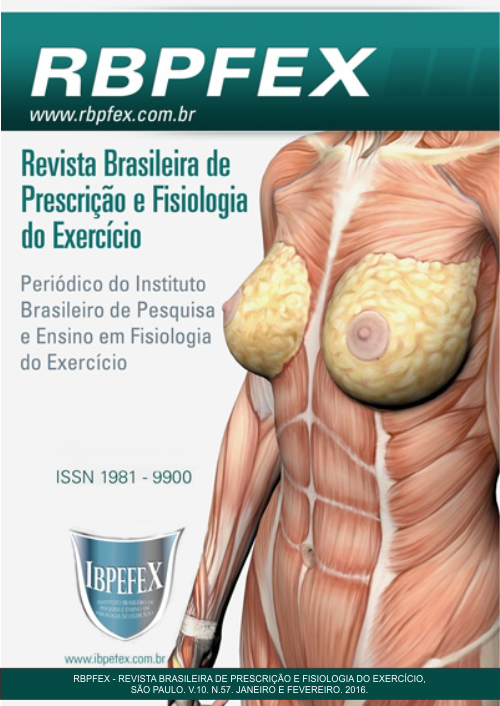Muscledysmorphia risk goers academies from downtown São Paulo
Abstract
Introduction: Muscle Dysmorphia (DYSMUS) is a disorder characterized by excessive preoccupation with the body volume and development of muscles. This study aimed to analyze the prevalence of susceptibility to DYSMUS between men practitioners of physical activity in gyms from the center of Sao Paulo. Materials and Methods: A questionnaire was applied adapted (MASS) and analyzed the ratio B / P (arm circumference contracted divided by the circumferenceof the calf) to identify the risk DISMSUS. The BMI of the participants was calculated and questions were applied about their feeding. Results and Discussion: We evaluated 51 physically active men, mean age 29.1 years. It was observed that 54.9% of the participants were overweight. According to the ratio B / P, 35% of participants had probable risk of developing DYSMUS and 27.5% risk of disorder by MASS score. Conclusion: Approximately one third of participants had risk DYSMUS according to one of the parameters applied and 12% had risk according to the two parameters.
References
-Antunes, H.K.M.; Andersen, M.L.; Tufik, S., De Melo, M.T. O estresse físico e a dependência de exercício físico. Revista Brasileira de Medicina do Esporte. Vol. 12. 2006. p. 234-238.
-Assunção, S.S.M. Dismorfia muscular. Revista Brasileira de Psiquiatria. Vol. 24. Num. 3. 2002. p. 80-84.
-Azevedo, A.M.P.; Caminha, I.O. Estetização da saúde e dismorfia muscular: concepções sociais do corpo. ConScientia e Saúde. Vol. 10. Num. 3. 2011. p. 530-538.
-Azevedo,A.M.P.; Ferreira, A.C.D.; Silva, P.P.C.; Silva, E.A.P.C.; Caminha, I.O. Dismorfia muscular: características alimentares e da suplementação nutricional. ConScientiae Saúde. Vol. 10. Num.1. 2011. p. 129-137.
-Behar, R.; Molinari, D. Dismorfia muscular, imagen corporal y conductas alimentarias en dos poblaciones masculinas. Revista Medica de Chile. Vol. 138. 2010. p. 1386-1394.
-Cafri, G.; Olivardia, R.; Thompson, J.K. Symptom characteristics and psychiatric comorbidity among males with muscle dysmorphia. Comprehensive psychiatry. Vol. 49. 2008. p. 374-379.
-Cascales, M.J.A.; Bertsos, A.Y.; Server, I.D. Trastornos de alimentación en hombres. Revista de Fundamentos de Psicologia. Vol. 3. Num. 1. 2011.
-Costa, S.P.V.; Guidoto, E.C.; Camargo, T.P.P; Uzunian, L.G.; Viebig, R.F. Distúrbios da Imagem Corporal e Transtornos Alimentares em Atletas e Praticantes de Atividade Física. Revista Digital –Buenos Aires. Vol. 12. Num. 144. 2007.
-Duran, A.C.F.L.; Latorre, M.R.D.O.; Florindo, A.A.; Jaime, P.C. Correlação entre consumo alimentar e nível de atividade física habitual de praticantes de exercícios físicos em academia. Revista Brasileira de Ciência e Movimento. Vol. 12. Num. 3. 2004. p. 15-19.
-Lima, L.D.; Moraes, C.M.B.; Kirsten, V.R. Dismorfia Muscular e o Uso de Suplementos Ergogênicos em Desportistas. Revista Brasileira de Medicina do Esporte. Vol. 16. Num. 6. 2010.
-Molina, A.M.R. Vigorexia: Adicción, Obsesión o Dismorfia; un Intento de Aproximación. Rev Salud y drogas. Vol.7. Num. 2. 2007. p. 289-308.
-Mota, C.G.; Aguiar, E.F. Dismorfia Muscular: Uma nova Síndrome em Praticantes de Musculação. Revista Brasileira de Ciências da Saúde. Vol. 9. Num. 27. 2011.
-Nacif, M.A.L.; Viebig, R.F. Avaliação antropométrica de adultos. Avaliação Antropométrica nos Ciclos da Vida. 2. ed. São Paulo. Metha. 2011. p. 20.
-Olivardia, R.; Junior, H.G.P.; Hudson, J.I. Muscle Dysmorphia in male weightlifters: A case-control study. American Journal of Psychiatry. Vol. 157. Num. 8. 2000. p. 1291-1296.
-Sánchez, R.M.; Moreno, A.M. Ortorexia y Vigorexia: ¿Nuevos transtornos de La conducta alimentaria? Transtornos de La conducta alimentaria. Vol.5. 2007. p. 457-482.
-Sardinha, A.; Oliveira, A.J.; Araujo, C.G.S. Dismorfia Muscular: Analise Comparativa Entre um Critério Antropométrico e um Instrumento Psicológico. Revista Brasileira de Medicina do Esporte. Vol. 14. Num. 4. 2008.
-Savoia, M.G. Instrumentos para a avaliação de eventos vitais e de estratégias de enfrentamento (coping) em situações de estresse. In: Gorenstein, L.H.S.; Andradre, A.W.Z (Eds.). Escalas de avaliação clínica em psiquiatria e psicofarmacologia. São Paulo. Lemos-Editorial. 2000. p. 377-386.
-Schmitz, J.F.; Campagnolo, P.D.B. Características de Dismorfia Muscular em Praticantes de Musculação: Associação com o Consumo Alimentar. Brazilian Journal Sports Nutrition. Vol. 2. Num. 2. 2013. p. 1-8.
-Silva, C.F.P.; Gutierrez, I.F.; Loureiro, S.S.; Oliveira, T.C.; Nacif, M. Sinais e sintomas característicos de vigorexia em homens praticantes de musculação. Revista Digital Buenos Aires. Vol. 19. Num. 200. 2015.
-Vieira, J.L.L; Rocha, P.G.M; Ferrarezzi, R.A.A. Dependência pela prática de exercícios físicos e o uso de recursos ergogênicos. Acta Sci Health Sci. Vol. 32. Num. 1. 2010. p. 35-41.
-World Health Organization. Physical status: the use and interpretation of anthropometry. Geneva: WHO (WHO -Technical Report series, 854) 1995.
-World Health Organization. Obesity: preventing and managing the global epidemic. Report of a World Health Organization Consultation. WHO Obesity Technical Report Series, Geneva: World Health Organization. 2000. p. 284:256.
Authors who publish in this journal agree to the following terms:
- Authors retain the copyright and grant the journal the right of first publication, with work simultaneously licensed under the Creative Commons Attribution License BY-NC which allows the sharing of the work with acknowledgment of the authorship of the work and initial publication in this journal.
- Authors are authorized to enter into additional contracts separately for non-exclusive distribution of the version of the work published in this journal (eg, publishing in institutional repository or book chapter), with acknowledgment of authorship and initial publication in this journal.
- Authors are allowed and encouraged to post and distribute their work online (eg, in institutional repositories or on their personal page) at any point before or during the editorial process, as this can bring about productive change as well as increase impact and impact. citation of published work (See The Effect of Free Access).






